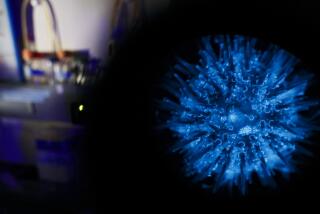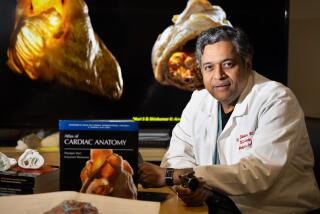In a first, scientists rid human embryos of a potentially fatal gene mutation by editing their DNA

Researchers used eggs from healthy females and the sperm of a man who carried a gene mutation that causes inherited hypertrophic cardiomyopathy. (Aug. 3, 2017) (Sign up for our free video newsletter here http://bit.ly/2n6VKPR)
Using a powerful gene-editing technique, scientists have rid human embryos of a mutation responsible for an inherited form of heart disease that’s often deadly to healthy young athletes and adults in their prime.
The experiment marks the first time that scientists have altered the human genome to erase a disease-causing mutation not only from the DNA of the primary subject but from the genes of his or her progeny as well.
The controversial procedure, known as “germ-line editing,” was conducted at Oregon Health and Science University in Portland using human embryos expressly created for the purpose. It was reported Wednesday in the journal Nature.
Scientists’ ultimate goal is to fix gene mutations that lead to debilitating or fatal diseases, and to prevent the propagation of those mutations to future generations. Study leader Shoukhrat Mitalipov, a biologist at OHSU, said the new findings might correct genetic variants that can cause breast and ovarian cancer, cystic fibrosis and muscular dystrophy in those who inherit them.
But others fret that the technique may be used for less noble purposes, such as creating designer babies with desired traits like green eyes, an athletic build or an aptitude for mathematics.

Study leader Shoukhrat Mitalipov explains how his team edited the DNA of a human embryo to fix a mutant gene that causes an inherited heart disease called hypertrophic cardiomyopathy.
In the United States, the Food and Drug Administration currently forbids any use of germ-line editing outside of a research setting.
But recent history has shown that people who want access to such techniques “can find people willing to perform them in venues where they’re able to do so,” said Jeffrey Kahn, who directs Johns Hopkins University’s Berman Institute of Bioethics.
“It will happen whether we discuss it or not, and we need to talk about these things before they happen,” said Kahn. “That’s now.”
The new research comes less than six months after the National Academies of Science, Engineering and Medicine recommended that scientists limit their trials of human germ-line editing to diseases that could not be treated with “reasonable alternatives” — at least for the time being.
In a bid to make the experiment relevant to the real-life problems faced by parents who carry disease-causing mutations, the researchers focused on a gene variant that causes inherited hypertrophic cardiomyopathy.
In this condition, a parent who carries one normal and one mutated copy of the MYBPC3 gene has a 50-50 chance of passing the faulty copy on to his or her offspring. If the child inherits the mutation, his or her heart muscle is likely to grow prematurely weak and stiff, causing heart failure and often early death.
In diseases in which one parent carries a gene like this, a couple will often seek the assistance of fertility doctors to minimize the risk of passing the mutation on to a child. A woman’s eggs and man’s sperm meet in a lab using in vitro fertilization. Then specialists inspect the resulting embryos, cull the ones that have inherited an unwanted mutation, and transfer unaffected embryos into a woman’s uterus to be carried to term.
In the new research, researchers set out to test whether germ-line gene editing could make the process of choosing healthy embryos more effective and efficient by creating more of them.
It could. The targeted correction of a disease-causing gene carried by a single parent “can potentially rescue a substantial portion of mutant human embryos, thus increasing the number of embryos available for transfer,” the study authors reported.
The fix was made possible by a system known as CRISPR-Cas9, which has been sweeping through biology labs because it greatly simplifies the gene-editing process. It uses a small piece of RNA and an enzyme to snip out unwanted DNA and, if desired, replace it with something better.
If the process is found to be safe for use in fertility clinics, it “could potentially decrease the number of cycles needed for people trying to have children free of genetic disease,” said Dr. Paula Amato, a coauthor and professor of obstetrics and gynecology at Oregon Health and Science University.
The team encountered several scientific surprises along the way. Long-feared effects of germ-line editing, including collateral damage to “off-target” genetic sequences, scarcely materialized. And “mosaicism,” a phenomenon in which edited DNA appears in some but not all cells, was found to be minimal.
Mitalipov called these “exciting and surprising moments.” But he cautioned that “there is room to improve” the techniques for producing mutation-free embryos. Clinical trials would have to wait until the DNA editing showed a near-perfect level of efficiency and accuracy, he said, and could be limited by state and federal regulations.
“There is still a long road ahead,” said Mitalipov, who heads the Center for Embryonic Cell and Gene Therapy at OHSU.
Biologists, fertility doctors and ethicists have long anticipated that scientists would one day manipulate the DNA of human embryos. Now that the milestone has been reached, it drew a mix of praise and concern from experts in genetic medicine.
Dr. Richard O. Hynes, who co-chaired the National Academies’ report issued in February, called the new study “very good science” that advances the understanding of genetic repair on many fronts. Hynes, who was not involved with the research effort, said he was “pleasantly surprised” by the Oregon-based team’s “clever modifications” and their outcomes.
“It’s likely to become feasible, technically — not tomorrow, not next year, but in some foreseeable time. Less than a decade, I’d say,” said Hynes, a biologist and cancer researcher at MIT and the Howard Hughes Medical Institute.
UC Berkeley molecular and cell biologist Jennifer Doudna, one of pioneers of the CRISPR-Cas9 gene-editing system, said the new research highlights a prospective use of gene editing for one inherited disease and offers some insights into the process. But she questioned how broadly the experiment’s results would apply to other inherited diseases.
Doudna also said she does not believe using germ-line editing to improve efficiency at fertility clinics meets the criteria laid out by the National Academies of Sciences, which urged that the technology be explored only in cases in which it’s needed essentially as a last resort.
“Already, 50% of embryos would be normal,” she said. “Why not just implant those?”
Doudna said she feared that the new findings “will encourage people to proceed down this road” before the scientific and ethical implications of germ-line editing have been fully considered.
“A large group of experts concluded that clinical use should not proceed until and unless there’s broad societal consensus, and that just hasn’t happened,” she said. “This study underscores the urgency of having those debates. Because it’s coming.”
The study authors — a multinational team of geneticists, cardiologists, fertility experts and embryologists from OHSU, the Salk Institute in La Jolla, and labs in South Korea and China — tested a number of innovations in an effort to improve the safety, efficiency and fidelity of gene editing. And most yielded promising results.
After retrieving eggs from 12 healthy female volunteers, the researchers simultaneously performed two steps that had never been combined in a lab: fertilizing the eggs with sperm and introducing the CRISPR-Cas9 repair machinery.
The resulting embryos took up the gene-editing program so efficiently and uniformly that, after five days of incubation, 72.4% of the 58 embryos tested were free of the MYBPC3 mutation. By comparison, when there was no attempt at gene editing, just 47.4% of embryos were free of the mutation responsible for the deadly heart condition.
The researchers believe their method prompted the embryos to rely on the healthy maternal copy of the gene as a model for fixing the MYBPC3 mutation, and not a repair template that used DNA from the sperm donor’s normal version of the gene. Only one of the 42 embryos used the introduced template for repair. The scientists contrasted this process to stem cells, which do use repair templates.
The embryos’ cells divided normally as they matured to the blastocyst stage, the point at which they would usually be ready for transfer to a woman’s uterus. After extensive testing, the embryos were used to make embryonic stem-cell lines, which are stored in liquid nitrogen and can be used in future research.
Researchers also noted that genetic mosaicism — a concern raised by earlier experiments in gene-editing — was virtually absent from 41 of the 42 embryos that were free of the disease-causing mutation.
MIT’s Hynes said such findings offer important insights into how human embryos grow, develop and respond to anomalies, and will help families facing infertility and inherited illnesses.
“Human embryogenesis is clearly different from that of a mouse, which we know a lot about,” Hynes said. “That needs to be studied in human embryos, and there’s no other way to do it.”
At the same time, he downplayed fears that embryologists would soon tinker with such attributes as looks, personality traits and intelligence in human children.
“We’re not looking at designed babies around the corner — not for a long time,” he said.
MORE IN SCIENCE
The DNA of ancient Canaanites lives on in modern-day Lebanese, genetic analysis shows
Is it Alzheimer’s or another dementia form? Why doctors need to distinguish and how they might do so
UPDATES:
3:50 p.m.: This story has been updated with comments from Jeffrey Kahn of Johns Hopkins University’s Berman Institute of Bioethics.
This story was originally published at 10 a.m.







